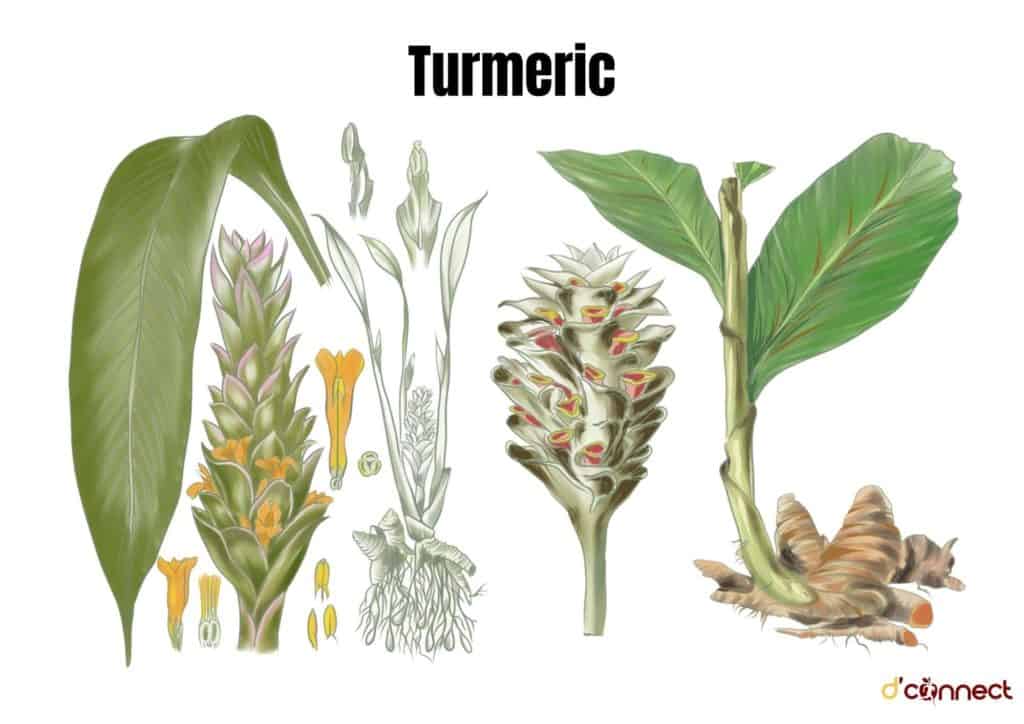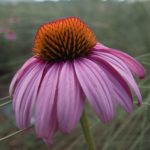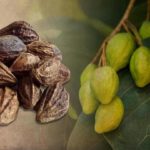
Ali Mercep
BNatMed, MNMHNZ, Medical Herbalist, RN, HV
Note — The article was checked and updated December 2023.
A member of the ginger family, turmeric today has many purposes. Apart from finding its way to our kitchen, we are also using it for beverages, tonics and in different dosages to support our physical and mental health.
The key active component in turmeric is curcumin, which gives turmeric it’s yellow pigment.
Curcumin has been widely studied over the last few decades, and while much of the research is still ongoing, scientists have found quite interesting details about how curcumin can help to enhance our health and recovery, which we have covered in more detail in the article.
Introduction
Turmeric is a perennial herb yielding a rhizome that produces a yellow powder which gives curry its characteristic colour.
Family: Zingiberaceae
Species: C.longa
Genus: Curcuma
Kingdom: Plantae[1]
Turmeric was most probably first cultivated as a dye, since it is used to colour the robes of Hindu priests, and then as a condiment and cosmetic. Turmeric has been a part of hindu religious ceremonies and is often applied as a paste mixed with sandalwood to the foreheads of Hindus.

In Chinese medicine turmeric was used in the treatment of inflammatory and digestive disorders and used in a tooth powder or paste. In ayurvedic medicine, turmeric is used to
- Strengthen the overall energy of the body
- Relieve gas
- Dispel worms
- Improve indigestion
- Dissolve gallstones
- Purify the blood[2]
RELATED — Introduction to Ayurveda: Ancient medicinal healing methods
Turmeric is great for just about all aspects of our wellbeing
Famous for containing curcumin, a phytochemical with anti-inflammatory properties, makes turmeric useful for any inflammation that the body might be suffering from.
In the last few decades, despite its longstanding use in India and China, the therapeutic actions of turmeric were well researched. This mostly happened due to widespread interest in food and medicines that lowered cholesterol levels or had antioxidant properties (neutralization of harmful free radicals).[3,4]
Research has shown that turmeric’s powerful agents and compounds increase blood supply to areas of the body that need enhanced circulation, which makes this an ideal spice for those who have chronic histamine reactions due to a sluggish liver or poor circulation.
Turmeric’s high level of manganese, combined with its curcumin, make it great for the cardiovascular system.
Also, it lowers bad cholesterol and raises good cholesterol, while manganese activates the curcumins ability to extract toxic heavy metals from our system.[4]
Other names
- Curcuma domestica
- Indian saffron (Engl)
- Kurkuma wurzel stock, Gelbwurzel (Ger)
- Rhizome de curcuma, Safran des Indes (Fr)
- Gurkmeja (Dan)
- Jiang Huang (Chin)
- Shati (Sanskrit)[5]

Note — feel free to share or download this illustration.
Characteristics
Native to India and southeast Asia, turmeric is presently cultivated in many countries but India accounts for a large percentage.
Turmeric plant is an aromatic perennial reaching 90cm (3ft). It has a short stem, pointy shaped leaves and a knobbly rhizome. The fresh rhizome is bright yellow inside.
Key constituents
- Volatile oil (3-5%) including zingiberene and tumerone (the principal sesquiterpenes obtained from turmeric)
- Curcumin
- Bitter principles
- Resin Chevalier
The rhizome is carefully unearthed and broken into sections. It is boiled or steamed before drying.[1]
Use
Turmeric and especially its most active compound curcumin have many scientifically proven health benefits, such as the potential to improve heart health and prevent against Alzheimer’s disease.
Medicinal use
Medicinal Actions
- Antioxidant
- Anti-inflammatory
- Antimicrobial
- Carminative
- Circulatory stimulant
- Hypolipidemic
- Liver hepatoprotective
Turmeric is used internally for digestive complaints as it promotes liver function and bile flow and production. Also it protects the liver against toxic exposure.
As a digestive aid, it will relieve flatulence and protect the stomach mucosa against ulceration of the stomach. It may assist with conditions such as inflammatory bowel disease, ulcerative colitis, gastric ulcers and dyspepsia.[6]
As an anti-inflammatory agent, turmeric can be useful for arthritic conditions, such as rheumatism and osteoarthritis, bruises, sprains and sore inflamed painful joints. After a workout turmeric can shorten the recovery time for muscles, ligaments and joints.[7]
Also, turmeric has been shown to have protective effects on the cardiovascular system including
- Lowering cholesterol
- Triglyceride levels
- Inhibiting platelet aggregation[8]
Anti-cancer properties of turmeric are still being researched, and current results look hopeful.[5]
Turmeric has also proven to be useful for skin conditions such as psoriasis and fungal infections such as athlete’s foot.[9]
Culinary uses
In the food industry, turmeric is used to colour French mustard, and it’s an inexpensive substitute for saffron in cooking.

Warm and spicy, with a slightly bitter taste, turmeric is often used to season a variety of meat, rice and vegetables in Middle Eastern and Asian cuisines. Indonesian cuisine uses it in savory and sweet dishes, soups and stir fries.
Turmeric tea is also popular. It is a soothing blend of ground turmeric, lemon juice and honey.
We also have turmeric latte – which is a mix of turmeric, plain milk with ginger, cardamom, cinnamon and black pepper added.[10]
Nutritional facts
One tablespoon (1 tbsp = 9 grams) of turmeric contains[4]
Name | Amount | DV (daily value) |
Carbohydrate | 6.31g | 2% |
Fiber | 2.13g | 8% |
Fat | 0.3g | – |
Protein | 0.9g | 2% |
Vitamin E | 0.42mg | 2% |
15.79mg | 1% | |
0.12mg | 13% | |
5.17mg | 29% | |
19.55mg | 5% | |
Manganese | 1.86mg | 81% |
195.52mg | 4% | |
0.42mg | 4% |
Turmeric is high in iron and manganese
Health benefits
Increases the antioxidant capacity of the blood
Studies have shown that turmeric has significant antioxidant properties. Turmeric not only exerts direct free radical scavenging activity, it also increases the amount of endogenous antioxidants like glutathione.[11]
Oxidative damage contributes to aging and many diseases
Boosts brain derived neurotrophic factors (BDNF)
BDNF is a protein which plays a role in memory and learning. A reduction in BDNF can lead to memory loss and behavioral disorders.[12]
Lowers risk of heart disease
Studies have shown the anti-thrombotic and anti-inflammatory effects of curcumin in decreasing the serum cholesterol levels which may provide protection against the pathological changes that occurs with atherosclerosis.[8]

May help prevent cancer
Curcumin has been studied for its many effects on tumor growth. It is known to inhibit oncogenesis (tumor development) during both the promotion and progression periods in a variety of cancers.[13]
RELATED — Anti-cancer foods: The Healthiest Herbs and Spices (Part 4)
Alzheimer’s disease
Studies have shown that curcumin help the macrophages (white blood cells) to clear the amyloid plaques (collections of proteins that form in the spaces between the nerve cells) which play a central role in Alzheimer’s.[14]
Arthritis
Curcumin is one of the most promising natural ingredients in the treatment of arthritis. It was found to be effective in improving morning stiffness, walking time and joint swelling.
Depression
Evidence has found curcumin can raise serotonin and dopamine levels within the brain. It has also been found to produce antidepressant like effects by reducing the inflammatory responses and neuronal abnormalities derived from stress exposure.[15]
RELATED — Introduction to: Depression
Delay aging and age related chronic disease
Turmeric has shown potential to prevent DNA damage and help DNA repair. This means that it is able to help prevent disease and slow down the aging process.
Therapeutic dosage
Therapeutic dosage for tumeric in an adult is considered to be:
- Liquid: 35-100ml, weekly (1:1 liquid)
- Tablet: 4-10g, daily[16]
Turmeric can be used as a poultice using a paste made with turmeric powder.
Psoriasis — mix 1 tsp with a little water and apply three times a day.
Gastritis — take 1 tsp with water three times a day.[2,16]
Safety concerns
Turmeric is considered very safe at normal dietary dosages (half teaspoon to 1.5 teaspoon).
Caution should be used if a person has issues with biliary obstruction, gallstones and stomach hyperactivity.[14]
If pregnant, lactating or trying to conceive, it is recommended to talk to your medical practitioner about acceptable amounts and frequency.
Important to mention is that if you are applying topical doses of turmeric or curcumin, you should not expose yourself to excessive sunlight.
Turmeric will make your skin very sensitive under sunlight.[2]
Possible interactions with medications
Turmeric should not be taken with antiplatelet drugs. This is due to anti platelet activity and possible risk of bleeding.
Use of concentrated extracts should be suspended 1 week prior to major surgery.
Turmeric can also inhibit or enhance chemotherapy drugs, and it is shown to have additive effects with NSAIDS and anticoagulants.[5]
Possible interactions with herbs and supplements
Avoid using turmeric with other herbal/health supplements that can also affect blood clotting such as
- Clove
- Dan shen
- Dandelion
- Garlic
- Ginger
- Angelica (dong quai)[5]
RELATED — Dandelion (Taraxacum officinale)
Also, if you would like to learn more about the benefits of clove and ginger, we suggest reading Anti-cancer foods: The Healthiest Herbs and Spices (Part 2).
Tips
If you are dealing with
- Congestion
- Cough
- Sore throat
- Cold and flu-like symptoms
try juicing fresh turmeric and ginger together to make a small dose of concentrated serum. Take small amounts / sips throughout the day. The juice will act as an expectorant and help speed up the healing process.
RELATED — Natural remedies: For our respiratory health (sinuses, throat and lungs)
After a workout or any heavy labor, I would encourage you to consume turmeric. It can be taken in any form – spice, juiced, tea, or as a supplement.
Turmeric can shorten recovery time for muscles, ligaments and joints after exercise
Turmeric & Ginger Shots (makes 2-4 servings)
As mentioned previously, these fiery immune boosting shots are a go to option for the first sign of a cold.
Ingredients:
- 4 inches of turmeric
- 4 inches of fresh ginger
- 2 oranges
- 4 garlic cloves
Run each ingredient through the juicer separately.
Then combine 1 teaspoon of turmeric juice, 1 teaspoon of ginger juice, ¼ teaspoon of garlic juice and ¼ cup of orange juice in a small glass. Stir and drink immediately.
Summary

Note — feel free to share or download this illustration.
If you liked the article, please leave a comment below. Most importantly, please share it with your friends, especially if you think that someone needs to spice up their life.
Ali Mercep is a registered naturopath and medical herbalist based in Auckland.
She earned her degree from South Pacific College of Natural Medicine, and is also a registered nurse with further studies in health promotion and supervision of young children and their families.
Ali has worked in a busy integrative practice but now works independently, and is the founder of Clarity Holistic Health and director of Holistic Skin Clinic.
Ali is passionate about educating people in the importance of exercise and good nutrition, and she especially likes working with children.
References
(1) Marciano, M., & Vizniak, N. (2018), Botanical medicine, herbs, nutrition, hormones and medication. Prohealth
(2) Chevallier, A., (2001). Encyclopedia of medicinal plants. Dorling Kindersley Limited
(3) Veitch, N., Smith, M., Barnes, J., Anderson, L., Phillipson, D. (2013). Herbal medicines (4th ed). Pharmaceutical Press.
(4) Hewlings, J., Kalman, D., (2017). Curcumin: A review of its effects on human health. 6(10):92. Retrieved from https://www.mdpi.com/2304-8158/6/10/92
(5) Mills, S., & Bone, K (2000). Principles and practice of phytotherapy: Modern herbal medicine. Churchill Livingstone
(6) Yadav, S., Sah, A., Jha, R., Sah, P., Shah, D. (2013). Turmeric (curcumin) remedies gastroprotective action. Jan-Jun; 7(13):42-46. Retrieved from https://www.researchgate.net/publication/255695470_Turmeric_curcumin_remedies_gastroprotective_action
(7) Campbell, M., Carlini, N., Fleenor, B. (2021). Influence of curcumin on performance and post-exercise recovery. Retrieved from https://pubmed.ncbi.nlm.nih.gov/32319320/
(8) Wanwarang, W., Cardiol, J. (2009). The protective role of curcumin in cardiovascular diseases. Retrieved from https://biomer.com/template/images/biomer/pdfs/curcumin/the-protective-role-of-curcumin-in-cardiovascular-diseases.pdf
(9) Singh, M., Lee, K., Kumar, P., Kang, S. Curcuma oil enhanced anti dermatophytic drug activity against candida albicans and tricophyton mentagrophytes. Retrieved from https://pubmed.ncbi.nlm.nih.gov/34325638/
(10) William, A., (2016). Medical medium life-changing foods. Hay House.
(11) Menon V,. Sudheer, A.(2007). Antioxidant and anti-inflammatory properties of curcumin. Retrieved from https://link.springer.com/chapter/10.1007/978-0-387-46401-5_3
(12) Sarraf, P., Parohan, M., Javanbakhit, M., Ranji-Burachaloo,S., Djali, M (2019). Short-term curcumin supplementation enhances serum brain-derived neurotrophic factor in adult men and women; a systematic review and dose response meta- analysis of randomized control trials. Nutr Res, 69: 1-8. Retrieved from https://www.sciencedirect.com/science/article/abs/pii/S0271531719301009?via%3Dihub
(13) Braun L., Cohen, M. (2015). Herbs and natural supplements, an evidence based guide (Vol 2). Elsevier Chevallier, A., (2001) Encyclopedia of medicinal plants. Dorling Kindersley Limited
(14) Mishra, S., Kalpana, P. (2008). The effect of curcumin (turmeric) on Alzheimer’s disease: An overview. Retrieved from https://www.ncbi.nlm.nih.gov/pmc/articles/PMC2781139/
(15) Ramaholimihaso, T., Bouazzaoui, F., Kaladjan, A. (2020) Curcumin in depression: Potential mechanisms of action and current evidence – A narrative review. Retrieved from https://www.frontiersin.org/articles/10.3389/fpsyt.2020.572533/full(16) Steel, S. (2015). Neal’s yard covent garden remedies. Dorling Kindersley






